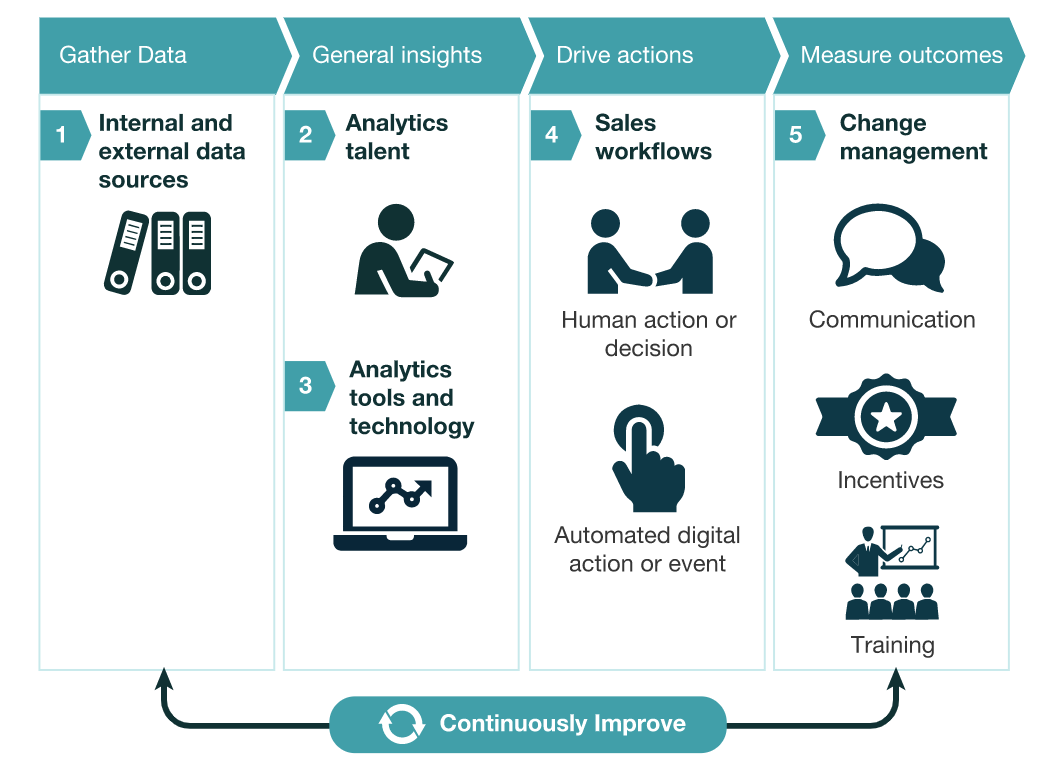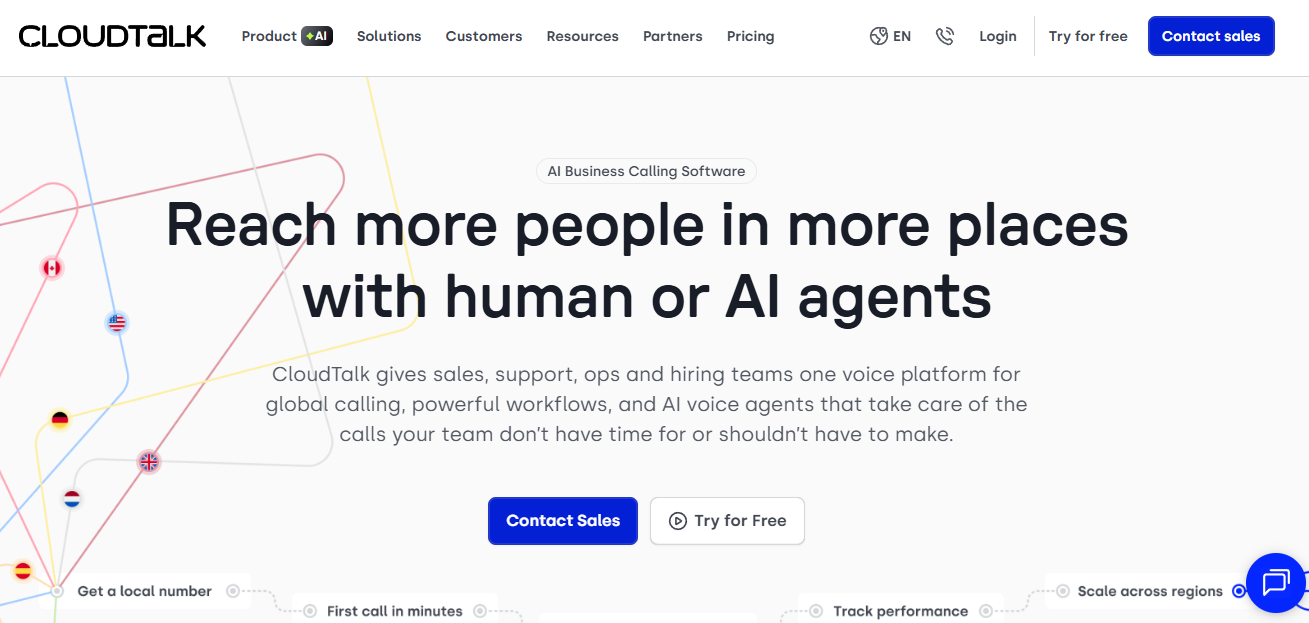%20(3).svg)
%20(3).svg)
The global predictive analytics market size is projected to reach USD 100.20 billion by 2034.
AI is changing the way sales teams work. Instead of relying only on instinct or past results, teams can use predictive sales analytics to understand what’s happening in the market and what will happen next.
They can see which deals may close, which customers need attention, and where new opportunities are emerging. It’s like giving your team a map of where to aim their efforts for the biggest results.
In this article, we will explore the key components, types, implementation strategies, and use cases of predictive sales analytics.

Predictive sales analytics utilizes previous transaction data, customer interactions, and external indicators to generate forecasts of sales outcomes and identify churn risks.
83% of sales teams with AI saw an increase in revenue in 2024 versus 66% of those without AI. The method differs from traditional sales reporting strategies due to better possibilities instead of basic summarizations.
For example, instead of insights into the last quarter’s closed deals, predictive analysis helps isolate active opportunities from dormant ones.
Predictive sales analytics transforms raw data into actionable insights that drive measurable revenue growth effectively.
Predictive sales analytics is a critical part of your business, as it moves your sales process from assumptions to measurable forecasts for informed decision-making.
Nowadays, static reports are unreliable for focused outcomes, and predictive analytics helps you evaluate customer retention and revenue growth to secure long-term success.
Here are some of the factors that make predictive analytics vital for sales operations in all modern data-driven organizations.
Let’s now explore the core components of predictive sales analytics that drive accurate forecasts and actionable insights.
The power of predictive sales analytics lies in turning everyday sales data into guidance your team can actually use. Instead of getting lost in reports or spreadsheets, it gives clear signals about who to reach out to, when to follow up, and which opportunities need more attention.
Predictive sales analytics works by bringing together three main elements: your data, smart models, and the tools that put insights into action.
Every predictive system starts with data, and most sales teams already have plenty of it from customer emails, invoice emails, call notes, deal histories, and website interactions. Predictive analytics connects all those dots and looks for the patterns behind wins and losses. This helps you understand which buyer behaviors signal real intent and which ones suggest hesitation.
For example, if your CRM shows that leads who attend a demo and engage with a follow-up email are twice as likely to buy. Automatically, the system highlights similar leads as high-priority opportunities.
Once your data is collected and cleaned, machine learning algorithms take over. They spot trends such as what types of companies usually convert or when deals tend to stall and use that knowledge to forecast what’s likely to happen next.
You don’t need to understand the math behind it. Consider it like a digital sales coach that is analyzing patterns and telling your team where to focus. Over time, they become better at predicting outcomes to help your team focus their time and energy on the leads most likely to close them without anyone needing to understand the complex math behind it.
Even the most accurate predictions mean little if your team can’t use them effectively. That’s where tools come in. Modern CRMs like Salesforce, HubSpot, Pipeline CRM or Clari now include predictive features built right in. They automatically score leads, flag deals at risk, and even recommend the next best actions. This is all inside the same system your team already uses.
Some advanced systems even use AI voice APIs to analyze tone and sentiment during live calls. These integrations detect how engaged or hesitant a buyer sounds in real time, giving reps instant feedback and helping them tailor their responses.
When integrated into CRM or revenue intelligence tools, this data adds a powerful emotional layer to predictive models. It helps sales teams identify engagement levels, detect hesitation or interest in real time, and fine-tune follow-ups based on actual conversational cues.
AI voice APIs transform every customer interaction into measurable insight and help teams predict outcomes with improved accuracy.
To understand sales performance, it is essential to evaluate the types of predictive sales models. Predictive sales analytics depends on three pillars: data, models, and tools.
Here are the common models.
These models rank prospects by their probability to convert, so your team can focus effort on the accounts most likely to close.
Forecasting models project revenue outcomes with greater accuracy by combining pipeline data, seasonal factors, and past performance.
Churn prediction models flag accounts at risk of leaving, giving you time to act before renewal revenue slips away.
Recommendation models point customers toward relevant add-ons or upgrades that increase deal size and strengthen relationships.
Now, businesses can implement predictive sales analytics by defining objectives, preparing data, selecting models, and integrating valuable insights.
.png)
Predictive sales analytics implementation begins with clear objectives, accurate data audits, and a model for tool selection and sales goals. Organizations embed predictions into CRM workflows, train teams for adoption, and monitor performance to keep models relevant.
Here is a step-wise analysis to implement predictive sales analytics:
Set precise goals for your program before you build models. Decide whether your focus is higher conversion rates, stronger forecasts, lower churn, or larger average deal size. These objectives guide which data you gather and which models you select.
Data quality defines prediction quality, so start with a full audit of your CRM and related systems. Standardize deal stages, remove duplicate contacts, and verify that engagement data is consistent across channels. A clean dataset prevents bias and ensures that outputs match real business conditions.
Different goals require different models and platforms. For example, regression may forecast revenue, while classification sorts leads by conversion likelihood. Evaluate whether native CRM tools, revenue intelligence platforms, or custom solutions best match your team’s skills and resources.
Predictions have value only when your reps can see and act on them inside their normal workflow. Embed scores into opportunity records, dashboards, or alerts in your CRM using AI sales tools so they inform daily activities. Linking predictions directly to playbooks helps move deals forward without adding complexity.
Analytics adoption depends on clarity and trust. Teach your team how to interpret scores, when to act on alerts, and how to give feedback when outputs look off. Higher confidence in the system ensures predictions turn into consistent behavior changes.
Model accuracy drifts as markets shift and behaviors change. Track metrics like forecast accuracy, lead-to-win conversion, and churn intervention success. Regular reviews and updates keep a program aligned with current sales conditions and maintain its long-term value.

Murf.ai offers a practical example of predictive sales analytics applied in a SaaS growth context. By combining CRM activity with product usage patterns, the platform identifies accounts most likely to expand into premium plans. Its AI voice API adds another layer of intelligence by tracking how prospects and customers interact with audio content, which then feeds predictive models to improve upsell and retention.

Clari provides another strong example, focused on revenue forecasting and deal inspection. The platform analyzes emails, call notes, and pipeline updates to surface risk signals in real time. Sales leaders use these insights to validate forecast numbers, coach reps on stalled opportunities, and prevent last-minute surprises at quarter-end.

CloudTalk brings predictive intelligence into the cloud call center space by analyzing call metadata, customer sentiment, and agent behavior. Sales teams use these insights to optimize outreach strategies, prioritize high-converting leads, and refine call scripts based on historical performance. Its seamless CRM integrations ensure predictive models are always fed with up-to-date engagement data. There are also alternative solutions available like Quo (formerly OpenPhone) for those looking to get more out of their call center software.
As Vineet Gupta, founder of 2xSaS, emphasizes, predictive sales analytics empowers data-driven organizations to turn historical data into precise, actionable strategies for higher revenues. This perspective ties together the practical use cases of Murf and Clari, showing how predictive intelligence drives tangible business impact.
The future of predictive sales analytics will center on smarter B2B sales, real-time insights, and responsible AI governance.
AI adoption in sales continues to expand, enabling teams to act on buyer intent signals faster and with more precision.
Organizations move toward predictive models that update instantly, ensuring decisions reflect the latest customer and pipeline activity.
Responsible practices in governance, including fairness and transparency, will define how much trust and value businesses gain from predictive systems.
Predictive sales analytics gives you a forward-looking view of your pipeline by combining CRM records, external signals, and advanced models.
With tools like lead scoring, revenue forecasting, churn detection, and product recommendations, your team can focus on the right opportunities and reduce wasted effort.
The future promises even greater accuracy through real-time insights and AI-driven personalization, balanced by the need for responsible governance.
But the real impact begins when you embed these insights into daily sales routines using data. This will help forecast trends and prioritize every customer interaction.
Start small. Identify one key stage in your sales funnel where predictive insights could make decisions faster or smarter. Over time, these small, data-driven adjustments can compound into a competitive edge that no intuition alone can match.

Joy D'Cruz is a content marketing specialist currently working with SaSHunt. Joy has a keen interest in researching topics related to B2B and SaaS. He has created copy for a wide range of marketing and business topics, including social media, email marketing, and career development.